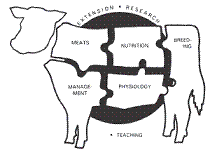Animal Science, Department of

Nebraska Beef Cattle Reports
Date of this Version
1-1-1996
Abstract
In the current cow-calf production system in the United States when restricted breeding seasons are used a heifer must calve by two years of age to obtain maximum lifetime productivity. Heifers that reach puberty at a younger age and have ≥3 estrous cycles have a greater chance of conceiving early in their first breeding season than contemporaries. Due to the longer postpartum period of an estrus of first-calf cows calving at two years age, heifers that conceive early in the breeding season have a greater opportunity to initiate estrous cycles before the next breeding season and become pregnant. In contrast, heifers that do not reach puberty until after the breeding season starts, conceive later in the breeding season and subsequently calve later the following year. Calving late in the calving season increases the chances of heifers not becoming pregnant during the following breeding season and being lost from the herd. Therefore, age at puberty is an important reproductive trait in developing replacement heifers.
Improved management practices and selection of reproductive traits have enhanced the physiological processes associated with attainment of puberty to maximize the number of heifers that reach puberty before the breeding season. Development of replacement heifers in the presence of a mature sterile bull is a management practice that decreases the age at which puberty is attained compared to heifers developed in the absence of a bull. However. increased selection pressure applied to age of puberty in heifers and the subsequent decrease in age at puberty has some disadvantages. Heifers reaching puberty and initiating estrous cycles at a young age while still suckling their dams are often exposed to fertile bulls during the darns breeding season or to intact male calves before weaning. Exposure to fertile bulls during this time period could result in heifers that become pregnant at a very young age and calve as yearlings. These heifers usually conceive late in the breeding season and calve late or after the normal calving season as yearlings. These heifers are of small body size which increases the chances of dystocia that sometimes results in loss of the calf and/or heifer, increased labor and time required for postpartum recovery. The combination of small body size and increased dystocia result in the majority of these animals failing to conceive during the following breeding season. Money invested in developing the heifer would be lost. In addition, precocious puberty in heifers that are destined to be sold as market animals results in heifers becoming pregnant prior to entering the feedlot. Pregnant feedlot heifers have decreased feed efficiency and growth rate compared to nonpregnant heifers which is a factor for lower prices paid by feedlots for heifers compared to steers. The research objectives were to determine the percentage of heifers developed at the University of Nebraska research station that exhibit precocious puberty and if exposure to bulls would affect the incidence of precocious puberty.


Comments
Published in 1996 Nebraska Beef Cattle Report; published by Agricultural Research Division, Institute of Agriculture and Natural Resources, University of Nebraska-Lincoln.